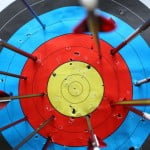
In another article I showed how the typography of numerals on a watch dial helps to build up the identity of a brand. In addition to the shape of the numerals, two other design choices have to be made: Arabic or Roman numerals… or no numerals at all (either hour markers or nothing at all).
This article is concerned with Roman numerals. You might think that Roman numerals are always chosen to show classicism, but you would be wrong! They are very graphic: they are never simply sticks with different extremities.
They are easy to read even upside down and don’t have to have their orientation changed around the dial (unlike Arabic numerals). Note that the number 4 is always depicted with four batons rather than “IV” to avoid any confusion with the 6 (VI).
Let’s see how three watch brands personalise their Roman numerals.
Breguet – la pearl of precision
Fine, slender and spaced out, the Roman numerals used by Breguet are those of a measuring instrument from history. The individual characters of a number – I, V, X – are linked by their serifs so that each numeral forms a compact unit. As a small black silhouette it echoes the sublime engine-turned decoration on the dial: the Breguet numeral is the epitome of finesse and precision, a small jewel of classicism with perfect proportions. Note the human touch of the lettering whose slightly irregular serifs and rounded tips makes you think of handcraftsmanship. The large space between each numeral recalls the precision of measuring instruments, since the hand can only point to it for a very short period of time.

Cartier – ostentatious chic
For the brand dominated by the panther, the notion “shape your time” is not just a slogan. The brand’s iconic Tank watch has severely inclined Roman numerals, like the rays of a sun around the axis of the hands, underscoring the watch’s characteristically rectangular shape. The ostentatious numerals of Cartier are instantly recognisable thanks to the strong contrast between the deep black of the thick strokes and the slender thin strokes. This is the geometry of Art Deco, offering a clear reading of the Roman numerals.
The open-worked versions of the Rotonde are also a great example of this graphical reinterpretation of the Roman numerals: they become architectural elements like the metal profiles of a tiny typographic skylight that encloses the movement.

Roger Dubuis – jazzy cadence
Roger Dubuis breaks new ground in the abstraction of the Roman numeral. Sans serif, the elements I, V and X look more like simple hour markers. But that isn’t all: thicker towards the outside of the dial than the inside, the numeral is deliberately deformed, like a reflection in an ice palace, so that it better fits on the circular dial. The shape is particularly drawn out on the ladies’ models, distracting you from reading them and forcing you to focus on their graphical rhythm and the jerky nature of time. Furthermore, the black and white versions of the Excalibur evoke, in a jazzy way, the keys of a piano.

In watchmaking as in all fields, typography is essential. The right typographical choice can solve problems of legibility, build on the values that strengthen the positioning of a brand and give it its unique touch.
Noémie Oulevay is co-founder of the graphic design agency Contreforme.
[“Source-worldtempus”]










